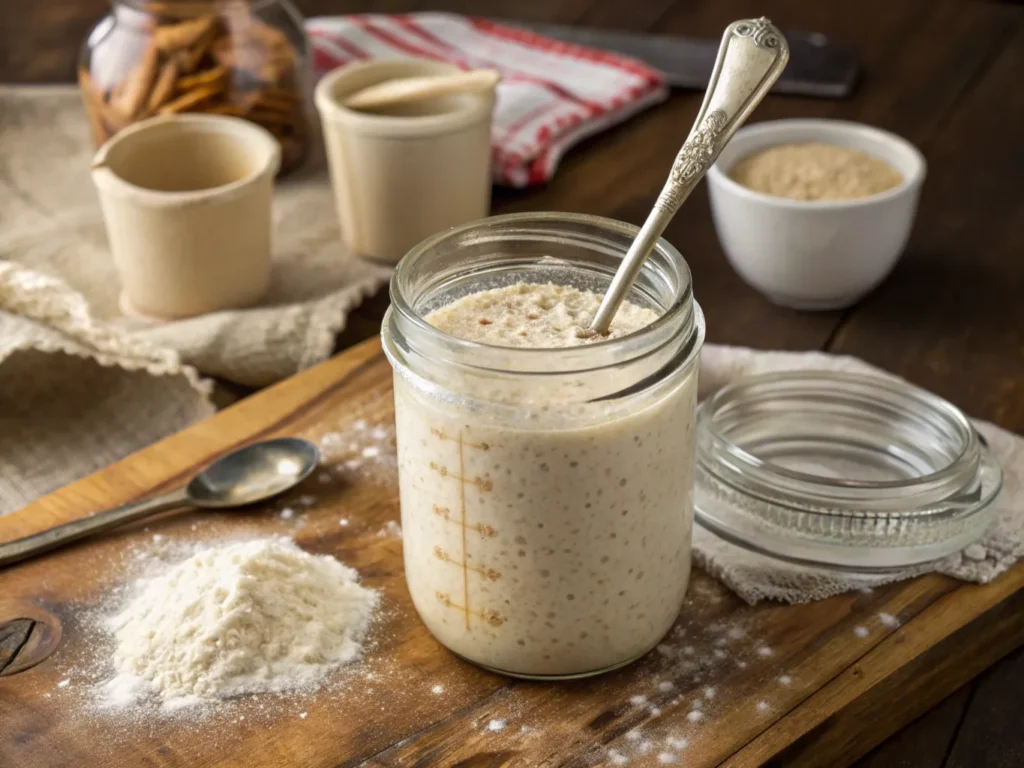Introduction
Let’s talk about sourdough bagels—a delicious mashup of the chewy, dense bagel texture we all love and the tangy flavor of sourdough. But here’s the big question: are sourdough bagels supposed to rise like other types of bread? If you’ve ever been elbow-deep in dough, staring at your bagels and wondering why they look suspiciously flat, you’re not alone!
Sourdough bagels have their quirks, and the rise process can be a bit mysterious. They don’t behave like regular bread dough, and that’s because sourdough fermentation is a whole different ball game. Today, we’re going to break it all down—what makes sourdough bagels tick, why the rise isn’t always dramatic, and what you can do to ensure your bagels turn out perfectly every time.
So grab a cup of coffee (or maybe some cream cheese?), and let’s get rolling—pun intended!
What Makes Sourdough Bagels Different from Regular Bagels?
Sourdough bagels are unique, and many bakers ask themselves, “Are sourdough bagels supposed to rise like regular bagels?” The answer lies in their slow fermentation process, which creates a subtle rise rather than a dramatic one.
The Unique Sourdough Fermentation Process
First off, sourdough bagels aren’t made with commercial yeast. Instead, they rely on a sourdough starter—a living, bubbly mix of flour and water teeming with wild yeast and lactic acid bacteria. This starter not only gives sourdough its signature tang but also means your dough takes its sweet time rising. Unlike bagels made with instant yeast, which can double in size in an hour or two, sourdough fermentation happens much slower.
Why? Well, wild yeast isn’t as aggressive as commercial yeast. It works at its own pace, and while that can test your patience, it’s worth it for the depth of flavor you get in return.
Why Sourdough Needs More Time to Rise
Because sourdough depends on wild yeast and bacteria, it requires more time for the dough to ferment and build structure. This slower process is actually a good thing. It develops the gluten gradually, leading to that signature chewiness we all associate with bagels.
But don’t expect sourdough bagels to puff up like a loaf of sandwich bread. They rise subtly, with the dough getting slightly plumper and firmer rather than doubling in size. That’s normal—bagels are supposed to be dense!
If you’re curious about the differences between sourdough bagels and regular ones, check out this comparison of sourdough vs. regular bagels for more insights.
Do Sourdough Bagels Rise the Same Way as Other Bread?
So, let’s address it directly: Are sourdough bagels supposed to rise like your favorite sourdough loaf? Not exactly! Sourdough bagels rise less dramatically due to their denser dough and the natural process of fermentation.
How Sourdough Fermentation Impacts Dough Behavior
Here’s the thing about sourdough bagels: they don’t play by the same rules as your average loaf of bread. Regular bread dough made with commercial yeast is like an overachiever—it rises fast and predictably, doubling or even tripling in size in just a few hours. Sourdough dough? It’s more like a slow-and-steady kind of friend.
Sourdough fermentation involves a delicate balance between wild yeast and lactic acid bacteria. While the yeast is responsible for the rise, the bacteria are busy developing flavor and breaking down starches in the flour. This teamwork is what gives sourdough its depth, but it also means your bagel dough will rise slower and less dramatically than you might expect.
The Science of Gluten Development in Bagels
Now let’s get a little nerdy (in the best way). Bagels, whether sourdough or not, are known for their dense texture. To achieve that perfect chew, the gluten network in the dough has to be strong enough to hold its shape. That’s why bagel recipes usually call for high-protein flour, like bread flour.
With sourdough, the gluten development happens over a longer period during fermentation. The natural acidity of sourdough strengthens the gluten bonds, which helps the dough hold its shape as it rises. But—and this is key—the rise is more subtle because bagel dough is much stiffer than most bread doughs. Less water means less expansion, so don’t expect your sourdough bagels to puff up like a marshmallow.
Common Misconceptions About Rising Sourdough Bagels
Why They Don’t Puff Up Dramatically
If you’re waiting for your sourdough bagels to look like big, fluffy bread rolls during proofing, you might be disappointed. Bagels are supposed to be dense by design. The tighter structure means the dough doesn’t have as much room to expand, so the rise is subtle at best.
Instead of doubling in size, sourdough bagel dough will look slightly puffier and feel softer to the touch after proofing. That’s a good sign! It means the wild yeast has done its job, and the dough is ready for the next step—shaping and boiling.
The Role of Bulk Fermentation and Proofing
Sourdough bagels go through two key rising phases: bulk fermentation and final proofing.
- Bulk fermentation is the initial rise right after you mix the dough. This is where most of the flavor develops, and the gluten begins to strengthen. Depending on the temperature and the strength of your starter, this can take anywhere from 4 to 12 hours.
- Proofing happens after you shape the bagels. This is a shorter, final rise that allows the dough to relax and get just the right amount of lift before boiling and baking.
A common mistake is expecting a dramatic rise during proofing. Instead, look for subtle changes in texture and size—it’s all about those small but mighty bubbles!
Step-by-Step Guide to Perfectly Risen Sourdough Bagels
Preparing Your Sourdough Starter

Before you even think about mixing your dough, your sourdough starter needs to be at its peak. That means it should be bubbly, active, and ready to party. If your starter has been chilling in the fridge, give it a couple of feedings to wake it up.
Here’s a quick trick: Drop a teaspoon of your starter into a glass of water. If it floats, it’s ready to go. If it sinks like a rock, give it a few more hours (or another feeding) and try again.
Mixing and Kneading Your Bagel Dough
Bagel dough is a bit tougher to work with than regular bread dough because it’s much stiffer. This lower hydration is what gives bagels their signature chew, but it can make the mixing and kneading process feel like an arm workout.
Here’s what to do:
- Combine ingredients: Mix your sourdough starter, flour, water, salt, and a touch of sweetener (like honey or malt syrup) in a large bowl. The dough will be rough and shaggy at first.
- Knead like you mean it: Knead the dough by hand for about 8–10 minutes or until it becomes smooth and elastic. You want it to feel firm but pliable, kind of like Play-Doh.
Bulk Fermentation: What to Expect
Now comes the waiting game—bulk fermentation. This is when the wild yeast and bacteria in your starter get to work, creating gas and flavor in the dough.
- Cover and rest: Place the kneaded dough in a greased bowl, cover it with a damp towel, and let it sit at room temperature.
- Be patient: Depending on your kitchen’s temperature, bulk fermentation can take 4–8 hours. In cooler environments, it might even need an overnight rest in the fridge.
Don’t expect the dough to double in size. Instead, look for subtle signs of life: slight puffiness, tiny bubbles under the surface, and a dough that feels airy when you press it.
Shaping and Final Proofing
Here’s where things get fun!

- Divide and shape: Once the dough has finished its bulk fermentation, divide it into equal pieces (typically 100–120g each for standard-sized bagels). Roll each piece into a ball, then poke your thumb through the center and stretch it into a bagel shape.
- Proof: Place the shaped bagels on a parchment-lined baking sheet, cover them with a towel, and let them proof for another 1–2 hours. Alternatively, you can pop them in the fridge overnight to slow the process down even more.
During proofing, the bagels will rise slightly but won’t get huge. The texture should feel soft and pillowy when they’re ready to boil.
How to Tell if Your Sourdough Bagels Have Risen Properly
Visual Cues: Shape, Size, and Texture
One of the most common questions bakers ask is, “Are sourdough bagels supposed to rise?” The easiest way to answer that is by trusting your eyes and hands. Risen sourdough bagels will look a bit puffier than when you first shaped them, but they won’t be dramatically larger. This subtle rise is a key characteristic of sourdough bagels. The surface should feel soft, with a slight give when you press it gently
The Poke Test: Checking for Readiness
Here’s a foolproof trick: Lightly poke the side of a bagel with your finger. If the dough springs back slowly and leaves a slight indentation, it’s ready to boil. If it springs back too quickly, give it more time.
Why Your Sourdough Bagels Might Not Be Rising
If you’ve tried everything and still find yourself wondering, “Are sourdough bagels supposed to rise?”, don’t worry. There are several reasons they might not puff up the way you expect, from a weak starter to improper proofing techniques. Here are some common reasons for a lack of rise and how to troubleshoot them.
Common Culprits: Weak Starter, Temperature, or Hydration
- Weak Starter:
If your sourdough starter isn’t active enough, your bagels won’t get the lift they need. Maybe it hasn’t been fed enough, or it’s too cold to do its job properly.- Fix it: Always feed your starter 8–12 hours before using it, and make sure it’s bubbly and floats in water before mixing it into your dough.
- Temperature Troubles:
Sourdough loves warmth, but not too much. If your kitchen is too cold, the fermentation process slows to a crawl. Conversely, if it’s too warm, the dough might overproof before it even rises properly.- Fix it: Keep your dough at a steady room temperature (around 75°F). If it’s chilly, try placing the bowl in a turned-off oven with the light on for a gentle heat boost.
- Too Dry (or Too Wet):
Bagel dough is supposed to be stiff, but if it’s too dry, the yeast won’t have enough moisture to thrive. On the flip side, if your dough is overly hydrated, the gluten structure can collapse.- Fix it: Stick to the recipe’s water-to-flour ratio, and use a kitchen scale for precise measurements.
Tips to Troubleshoot and Fix Rising Issues
If you’ve tried everything and your dough still won’t rise, don’t throw in the towel just yet. Here are some quick fixes:
- Give It More Time: Sourdough fermentation can be slow, especially in cooler conditions. If your dough hasn’t risen after the expected time, leave it alone for another hour or two.
- Try a Warm Proofing Spot: Place the dough in a proofing box, next to a warm window, or even on top of your fridge—anywhere with consistent warmth.
- Check Your Starter’s Strength: If your starter seems sluggish, take a small portion and give it a few extra feedings to wake it up. A well-fed starter can make all the difference.
- Stretch and Fold: During bulk fermentation, perform a couple of gentle stretch-and-folds every 30 minutes to help build strength and trap gas in the dough.
Can You Bake Sourdough Bagels If They Don’t Rise?
So, let’s say your dough just isn’t cooperating. Can you still bake those flat, sad-looking bagels? Absolutely! While they may not look picture-perfect, they can still taste fantastic with the right tweaks.
If you’ve faced rising challenges, learning more about making sourdough bagels at home can help you troubleshoot and perfect your process.
What Happens If You Bake Flat Bagels
Flat bagels might not have the ideal chewy texture, but they’ll still deliver on flavor. They’ll be denser than usual, but some people actually like that! Think of it as an artisanal take on a classic bagel.
Tricks to Improve Texture and Flavor
If you’re baking flat bagels, here are a few ways to up the wow factor:
- Boil Longer: A slightly longer boil (1–2 minutes per side) can help add chewiness and structure.
- Bake at a Higher Temperature: Crank up the oven heat (around 475°F) to get a nice, crisp crust.
- Toast Before Serving: Even if they didn’t rise as expected, a quick toast before eating can make them taste incredible.
Tips for Better Rising in Sourdough Bagels
Wondering, “Are sourdough bagels supposed to rise?” Getting your sourdough bagels to rise just right can feel like an art, but a few simple tweaks can make a big difference. From choosing the right ingredients to perfecting your technique, these tips will help you level up your bagel game.
Choosing the Right Flour
Not all flours are created equal, and the type you use can significantly affect how your dough rises.
- High-Protein Flour: Bagels need strong gluten development for their chewy texture, so opt for bread flour or high-protein all-purpose flour. Lower-protein flours, like cake or pastry flour, won’t give your dough the structure it needs to hold its shape.
- Fresh Flour: Stale or old flour can weaken gluten development, so always check the expiration date and store your flour in a cool, dry place.
Controlling Temperature During Proofing
Temperature is everything when it comes to sourdough. Too cold, and the yeast won’t activate; too warm, and you risk overproofing.
- Ideal Range: Keep your dough at 70°F–75°F during bulk fermentation. If it’s cooler in your kitchen, try proofing your dough in a warm spot like near a sunny window or inside your oven with just the light on.
- Refrigeration: For more flavor and flexibility, try a cold-proofing method. After shaping, let your bagels rest in the fridge overnight. This slows down fermentation and lets the flavors develop while ensuring the dough doesn’t overproof.
The Importance of Timing
Sourdough fermentation is a waiting game, and timing is key to achieving perfectly risen bagels.
- Don’t Rush: Give your starter plenty of time to become active before mixing it into the dough. Similarly, don’t cut corners during bulk fermentation or proofing—sourdough needs time to work its magic.
- Watch for Signs: Pay attention to your dough’s behavior rather than strictly following the clock. Look for visual cues like puffiness and small air bubbles to know when it’s ready.
Add a Little Sweetener
Traditional bagel recipes often include malt syrup or honey, which not only adds a hint of sweetness but also feeds the yeast during fermentation. A well-fed dough is a happy dough!
- How Much? A tablespoon or two is plenty for most recipes. Just make sure to mix it in thoroughly with the water before adding the flour.
Bonus: Pro Tips for That Perfect Rise
- Steam Is Your Friend: When baking your bagels, adding steam to your oven can help improve the rise and create a glossy crust. Place a pan of hot water on the bottom rack, or spritz the bagels with water before baking.
- Handle with Care: After proofing, be gentle with your dough to avoid deflating all that hard-earned rise.
- Don’t Skip the Boil: Boiling not only gives bagels their chewy texture but also locks in the shape. A well-risen bagel dough will float to the top of the water almost immediately—another good sign you’ve nailed the rise!
FAQs About Sourdough Bagels Rising
Do sourdough bagels rise as much as regular bagels?
Not quite! Many people wonder, “Are sourdough bagels supposed to rise as much as regular bagels?”, but the truth is they rise more slowly and subtly. This difference is part of what makes sourdough bagels special.
How long should sourdough bagels rise?
The total rising time for sourdough bagels depends on your starter’s activity and room temperature. During bulk fermentation, the dough typically needs 4–8 hours at room temperature or overnight in the fridge. After shaping, the final proofing takes another 1–2 hours, though it can also be extended overnight in the fridge for a cold proof.
Can I freeze sourdough bagel dough?
Absolutely! Freezing is a great way to save time. Shape your bagels, place them on a tray, and freeze until solid. Once frozen, transfer them to a bag or container. When you’re ready to bake, let them thaw and proof in the fridge overnight, then proceed with boiling and baking as usual.
Why is boiling bagels necessary?

Boiling bagels is a non-negotiable step that gives them their signature chewy crust. The hot water sets the outer layer of the dough, locking in its shape and creating a glossy finish. It also helps the bagels rise slightly during baking by trapping steam inside.
What should I do if my bagels are too dense?
Dense bagels can result from underproofing, overproofing, or a weak starter. If your bagels are too dense:
- Check your proofing time—it might need adjusting.
- Ensure your starter is active and bubbly before use.
- Use bread flour for better gluten development.
If all else fails, slice, toast, and enjoy them as they are. Even dense bagels can be delicious with a good schmear of cream cheese!
Can I still use my dough if it didn’t rise?
Yes, don’t throw it out! While your bagels might not turn out perfectly fluffy, they can still taste great. Try shaping and baking them as flatbreads or rolls. Alternatively, use the dough for bagel chips by slicing, toasting, and seasoning them.
Why did my sourdough bagels turn out flat?
Flat bagels are usually a sign of underproofing or overproofing. If the dough didn’t rise enough during fermentation, the gluten structure may not have been strong enough to hold its shape. On the other hand, if you proofed too long, the dough could collapse. To avoid this, watch for subtle puffiness and perform the poke test during proofing to ensure perfect timing.
Final Thoughts on Sourdough Bagels Rising
At the end of the day, the answer to “Are sourdough bagels supposed to rise?” is yes, but with a few caveats. They don’t rise as much as regular bread or bagels, but with the right technique, you’ll achieve that perfect, chewy texture.If you’re still exploring the nuances of sourdough baking, consider diving into resources like the sourdough vs. regular bagels comparison to learn more.
Don’t be discouraged if your first batch doesn’t turn out perfectly. Every sourdough adventure teaches you something new, whether it’s about timing, temperature, or simply trusting your instincts. Remember, sourdough bagels don’t need to rise dramatically to taste incredible. The beauty is in the journey—and, of course, the first bite of a fresh, homemade bagel!
So roll up your sleeves, get your starter bubbling, and give it a go. Whether your bagels come out tall or flat, they’re bound to be delicious with a generous schmear or your favorite topping.


2 thoughts on “Are Sourdough Bagels Supposed to Rise? Master the Perfect Bake!”
Comments are closed.